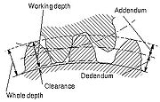
List of gear nomenclature
Encyclopedia
Gear
s have a wide range of unique terminology known as gear nomenclature. Many of the terms defined cite the same reference work.
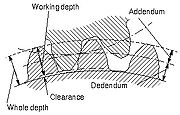 The addendum is the height by which a tooth of a gear projects beyond (outside for external, or inside for internal) the standard pitch circle or pitch line; also, the radial distance between the pitch circle and the addendum circle.
The addendum is the height by which a tooth of a gear projects beyond (outside for external, or inside for internal) the standard pitch circle or pitch line; also, the radial distance between the pitch circle and the addendum circle.
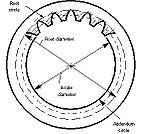
 The addendum circle coincides with the tops of the teeth of a gear and is concentric with the standard (reference) pitch circle and radially distant from it by the amount of the addendum
The addendum circle coincides with the tops of the teeth of a gear and is concentric with the standard (reference) pitch circle and radially distant from it by the amount of the addendum
. For external gears, the addendum circle lies on the outside cylinder while on internal gears the addendum circle lies on the internal cylinder.
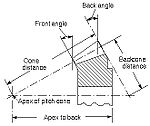
 Apex to back, in a bevel gear or hypoid gear, is the distance in the direction of the axis from the apex of the pitch cone to a locating surface at the back of the blank.
Apex to back, in a bevel gear or hypoid gear, is the distance in the direction of the axis from the apex of the pitch cone to a locating surface at the back of the blank.
, and usually is equal to the pitch angle.
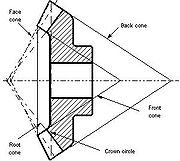 The back cone of a bevel or hypoid gear is an imaginary cone tangent to the outer ends of the teeth, with its elements perpendicular to those of the pitch cone. The surface of the gear blank at the outer ends of the teeth is customarily formed to such a back cone.
The back cone of a bevel or hypoid gear is an imaginary cone tangent to the outer ends of the teeth, with its elements perpendicular to those of the pitch cone. The surface of the gear blank at the outer ends of the teeth is customarily formed to such a back cone.
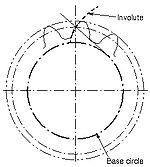 The base circle of an involute gear is the circle from which involute tooth profiles are derived.
The base circle of an involute gear is the circle from which involute tooth profiles are derived.
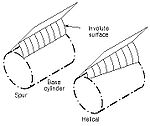 The base cylinder corresponds to the base circle, and is the cylinder
The base cylinder corresponds to the base circle, and is the cylinder
from which involute tooth surfaces are developed.
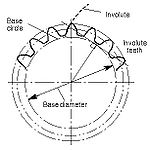 The base diameter of an involute gear is the diameter of the base circle.
The base diameter of an involute gear is the diameter of the base circle.
.
 Center distance (operating) is the shortest distance between non-intersecting axes. It is measured along the mutual perpendicular to the axes, called the line of centers. It applies to spur gears, parallel axis or crossed axis helical gears, and worm gearing.
Center distance (operating) is the shortest distance between non-intersecting axes. It is measured along the mutual perpendicular to the axes, called the line of centers. It applies to spur gears, parallel axis or crossed axis helical gears, and worm gearing.
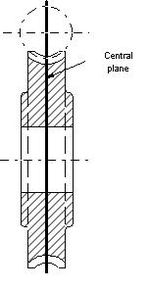 The central plane of a worm gear is perpendicular to the gear axis and contains the common perpendicular of the gear and worm axes. In the usual case with axes at right angles, it contains the worm axis.
The central plane of a worm gear is perpendicular to the gear axis and contains the common perpendicular of the gear and worm axes. In the usual case with axes at right angles, it contains the worm axis.
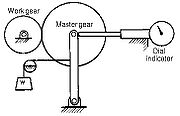 The composite action test (double flank) is a method of inspection in which the work gear is rolled in tight double flank contact with a master gear or a specified gear, in order to determine (radial) composite variations (deviations). The composite action test must be made on a variable center distance composite action test device.
The composite action test (double flank) is a method of inspection in which the work gear is rolled in tight double flank contact with a master gear or a specified gear, in order to determine (radial) composite variations (deviations). The composite action test must be made on a variable center distance composite action test device.
 Cone distance in a bevel gear is the general term for the distance along an element of the pitch cone from the apex to any given position in the teeth.
Cone distance in a bevel gear is the general term for the distance along an element of the pitch cone from the apex to any given position in the teeth.
Outer cone distance in bevel gears is the distance from the apex of the pitch cone to the outer ends of the teeth. When not otherwise specified, the short term cone distance is understood to be outer cone distance.
Mean cone distance in bevel gears is the distance from the apex of the pitch cone to the middle of the face width.
Inner cone distance in bevel gears is the distance from the apex of the pitch cone to the inner ends of the teeth.
teeth. The normals to the profiles of these teeth, at all points of contact, must pass through a fixed point in the common centerline of the two shafts.
The term crossed helical gears has superseded the term spiral gears. There is theoretically point contact between the teeth at any instant. They have teeth of the same or different helix angles, of the same or opposite hand. A combination of spur and helical or other types can operate on crossed axes.
 Crowned teeth have surfaces modified in the lengthwise direction to produce localized contact or to prevent contact at their ends.
Crowned teeth have surfaces modified in the lengthwise direction to produce localized contact or to prevent contact at their ends.
 Equivalent pitch radius is the radius of the pitch circle in a cross section of gear teeth in any plane other than a plane of rotation. It is properly the radius of curvature of the pitch surface in the given cross section. Examples of such sections are the transverse section of bevel gear teeth and the normal section of helical teeth.
Equivalent pitch radius is the radius of the pitch circle in a cross section of gear teeth in any plane other than a plane of rotation. It is properly the radius of curvature of the pitch surface in the given cross section. Examples of such sections are the transverse section of bevel gear teeth and the normal section of helical teeth.
. A face gear has a planar pitch surface and a planar root surface, both of which are perpendicular to the axis of rotation. It can also be referred to as a face wheel, crown gear, crown wheel, contrate gear or contrate wheel.
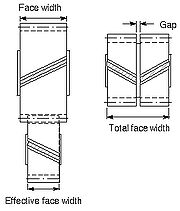 The face width of a gear is the length of teeth in an axial plane. For double helical, it does not include the gap.
The face width of a gear is the length of teeth in an axial plane. For double helical, it does not include the gap.
Total face width is the actual dimension of a gear blank including the portion that exceeds the effective face width, or as in double helical gears where the total face width includes any distance or gap separating right hand and left hand helices.
For a cylindrical gear, effective face width is the portion that contacts the mating teeth. One member of a pair of gears may engage only a portion of its mate.
For a bevel gear
, different definitions for effective face width are applicable.
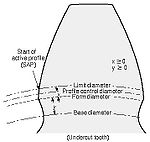 Form diameter is the diameter of a circle at which the trochoid (fillet curve) produced by the tooling intersects, or joins, the involute or specified profile. Although these terms are not preferred, it is also known as the true involute form diameter (TIF), start of involute diameter (SOI), or when undercut exists, as the undercut diameter. This diameter cannot be less than the base circle diameter.
Form diameter is the diameter of a circle at which the trochoid (fillet curve) produced by the tooling intersects, or joins, the involute or specified profile. Although these terms are not preferred, it is also known as the true involute form diameter (TIF), start of involute diameter (SOI), or when undercut exists, as the undercut diameter. This diameter cannot be less than the base circle diameter.
, denotes the angle between an element of the front cone and a plane of rotation, and usually equals the pitch angle.
is an imaginary cone tangent to the inner ends of the teeth, with its elements perpendicular to those of the pitch cone. The surface of the gear blank at the inner ends of the teeth is customarily formed to such a front cone, but sometimes may be a plane on a pinion or a cylinder in a nearly flat gear.
 The heel of a tooth on a bevel gear or pinion is the portion of the tooth surface near its outer end.
The heel of a tooth on a bevel gear or pinion is the portion of the tooth surface near its outer end.
The toe of a tooth on a bevel gear or pinion is the portion of the tooth surface near its inner end.
Distinction is made as to the direction and algebraic sign of this reading. A condition wherein the actual tooth flank position was nearer to the datum tooth flank, in the specified measuring path direction (clockwise or counterclockwise), than the theoretical position would be considered a minus (-) deviation. A condition wherein the actual tooth flank position was farther from the datum tooth flank, in the specified measuring path direction, than the theoretical position would be considered a plus (+) deviation.
The direction of tolerancing for index deviation along the arc of the tolerance diameter circle within the transverse plane.
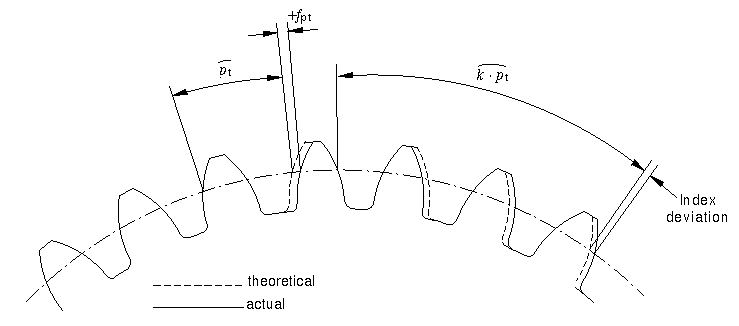
 The inside cylinder is the surface that coincides with the tops of the teeth of an internal cylindrical gear.
The inside cylinder is the surface that coincides with the tops of the teeth of an internal cylindrical gear.
 Inside diameter is the diameter of the addendum circle of an internal gear, this is also known as minor diameter.
Inside diameter is the diameter of the addendum circle of an internal gear, this is also known as minor diameter.
 Expressed as θ, the involute polar angle is the angle between a radius vector to a point, P, on an involute curve and a radial line to the intersection, A, of the curve with the base circle.
Expressed as θ, the involute polar angle is the angle between a radius vector to a point, P, on an involute curve and a radial line to the intersection, A, of the curve with the base circle.
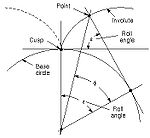 Expressed as ε, the involute roll angle is the angle whose arc on the base circle of radius unity equals the tangent of the pressure angle at a selected point on the involute.
Expressed as ε, the involute roll angle is the angle whose arc on the base circle of radius unity equals the tangent of the pressure angle at a selected point on the involute.
 Involute teeth of spur gears, helical gears, and worms are those in which the profile in a transverse plane (exclusive of the fillet curve) is the involute of a circle.
Involute teeth of spur gears, helical gears, and worms are those in which the profile in a transverse plane (exclusive of the fillet curve) is the involute of a circle.
 Mounting distance, for assembling bevel gears or hypoid gears, is the distance from the crossing point of the axes to a locating surface of a gear, which may be at either back or front.
Mounting distance, for assembling bevel gears or hypoid gears, is the distance from the crossing point of the axes to a locating surface of a gear, which may be at either back or front.

 A normal plane is normal to a tooth surface at a pitch point, and perpendicular to the pitch plane. In a helical rack, a normal plane is normal to all the teeth it intersects. In a helical gear, however, a plane can be normal to only one tooth at a point lying in the plane surface. At such a point, the normal plane contains the line normal to the tooth surface.
A normal plane is normal to a tooth surface at a pitch point, and perpendicular to the pitch plane. In a helical rack, a normal plane is normal to all the teeth it intersects. In a helical gear, however, a plane can be normal to only one tooth at a point lying in the plane surface. At such a point, the normal plane contains the line normal to the tooth surface.
Important positions of a normal plane in tooth measurement and tool design of helical teeth and worm threads are:
In a spiral bevel gear, one of the positions of a normal plane is at a mean point and the plane is normal to the tooth trace.
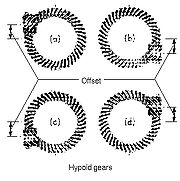 Offset is the perpendicular distance between the axes of hypoid gears or offset face gears.
Offset is the perpendicular distance between the axes of hypoid gears or offset face gears.
In the diagram to the right, (a) and (b) are referred to as having an offset below center, while those in (c) and (d) have an offset above center. In determining the direction of offset, it is customary to look at the gear with the pinion
at the right. For below center offset the pinion has a left hand spiral, and for above center offset the pinion has a right hand spiral.
 The outside (tip or addendum) cylinder is the surface that coincides with the tops of the teeth of an external cylindrical gear.
The outside (tip or addendum) cylinder is the surface that coincides with the tops of the teeth of an external cylindrical gear.
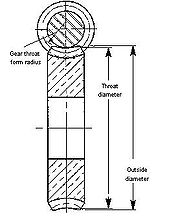 The outside diameter of a gear is the diameter of the addendum (tip) circle. In a bevel gear
The outside diameter of a gear is the diameter of the addendum (tip) circle. In a bevel gear
it is the diameter of the crown circle. In a throated wormgear it is the maximum diameter of the blank. The term applies to external gears, this is can also be known from major diameter.

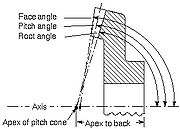
 Pitch angle in bevel gears, is the angle between an element of a pitch cone and its axis. In external and internal bevel gears, the pitch angles are respectively less than and greater than 90 degrees.
Pitch angle in bevel gears, is the angle between an element of a pitch cone and its axis. In external and internal bevel gears, the pitch angles are respectively less than and greater than 90 degrees.
These are the outline off the imaginary smooth roller or friction discs in every pair of mating gear. Many important measurement are taken on and from these circle.
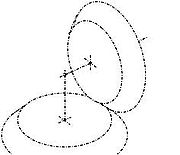 A pitch cone is the imaginary cone in a bevel gear that rolls without slipping on a pitch surface of another gear.
A pitch cone is the imaginary cone in a bevel gear that rolls without slipping on a pitch surface of another gear.
 A pitch cylinder is the imaginary cylinder in a spur or helical gear that rolls without slipping on a pitch plane or pitch cylinder of another gear.
A pitch cylinder is the imaginary cylinder in a spur or helical gear that rolls without slipping on a pitch plane or pitch cylinder of another gear.
 The pitch helix is the intersection of the tooth surface and the pitch cylinder of a helical gear or cylindrical worm.
The pitch helix is the intersection of the tooth surface and the pitch cylinder of a helical gear or cylindrical worm.
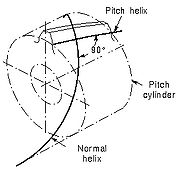 Outside helix angle is the helix angle on the outside cylinder.
Outside helix angle is the helix angle on the outside cylinder.
 Pitch surfaces are the imaginary planes, cylinders, or cones that roll together without slipping. For a constant velocity ratio, the pitch cylinders and pitch cones are circular.
Pitch surfaces are the imaginary planes, cylinders, or cones that roll together without slipping. For a constant velocity ratio, the pitch cylinders and pitch cones are circular.

 The pitch plane of a pair of gears is the plane perpendicular to to the axial plane and tangent to the pitch surfaces. A pitch plane in an individual gear may be any plane tangent to its pitch surface.
The pitch plane of a pair of gears is the plane perpendicular to to the axial plane and tangent to the pitch surfaces. A pitch plane in an individual gear may be any plane tangent to its pitch surface.
The pitch plane of a rack or in a crown gear is the imaginary planar surface that rolls without slipping with a pitch cylinder or pitch cone of another gear. The pitch plane of a rack or crown gear is also the pitch surface.
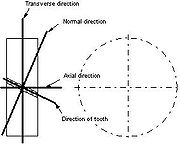 Principal directions are directions in the pitch plane, and correspond to the principal cross sections of a tooth.
Principal directions are directions in the pitch plane, and correspond to the principal cross sections of a tooth.
The axial direction is a direction parallel to an axis.
The transverse direction is a direction within a transverse plane.
The normal direction is a direction within a normal plane.
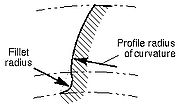 Profile radius of curvature is the radius of curvature of a tooth profile, usually at the pitch point or a point of contact. It varies continuously along the involute profile.
Profile radius of curvature is the radius of curvature of a tooth profile, usually at the pitch point or a point of contact. It varies continuously along the involute profile.
 Tooth-to-tooth radial composite deviation (double flank) is the greatest change in center distance while the gear being tested is rotated through any angle of 360 degree/z during double flank composite action test.
Tooth-to-tooth radial composite deviation (double flank) is the greatest change in center distance while the gear being tested is rotated through any angle of 360 degree/z during double flank composite action test.
Tooth-to-tooth radial composite tolerance (double flank) is the permissible amount of tooth-to-tooth radial composite deviation.
Total radial composite deviation (double flank) is the total change in center distance while the gear being tested is rotated one complete revolution during a double flank composite action test.
Total radial composite tolerance (double flank) is the permissible amount of total radial composite deviation.
 The root circle coincides with the bottoms of the tooth spaces.
The root circle coincides with the bottoms of the tooth spaces.
 The root cone is the imaginary surface that coincides with the bottoms of the tooth spaces in a bevel or hypoid gear.
The root cone is the imaginary surface that coincides with the bottoms of the tooth spaces in a bevel or hypoid gear.
 A shaft angle is the angle between the axes of two non-parallel gear shafts. In a pair of crossed helical gears, the shaft angle lies between the oppositely rotating portions of two shafts. This applies also in the case of worm gearing. In bevel gear
A shaft angle is the angle between the axes of two non-parallel gear shafts. In a pair of crossed helical gears, the shaft angle lies between the oppositely rotating portions of two shafts. This applies also in the case of worm gearing. In bevel gear
s, the shaft angle is the sum of the two pitch angles. In hypoid gears, the shaft angle is given when starting a design, and it does not have a fixed relation to the pitch angles and spiral angles.
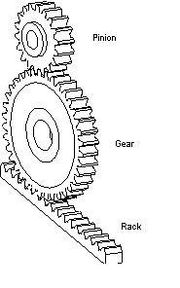 A spur gear has a cylindrical pitch surface and teeth that are parallel to the axis.
A spur gear has a cylindrical pitch surface and teeth that are parallel to the axis.
The pitch diameter is useful in determining the spacing between gear centers because proper spacing of gears implies tangent pitch circles. The pitch diameters of two gears may be used to calculate the gear ratio in the same way the number of teeth is used.


Where is the total number of teeth,
is the total number of teeth,  is the circular pitch,
is the circular pitch,  is the diametrical pitch, and
is the diametrical pitch, and  is the helix angle for helical gears.
is the helix angle for helical gears.


 The throat diameter is the diameter of the addendum circle at the central plane of a wormgear or of a double-enveloping wormgear.
The throat diameter is the diameter of the addendum circle at the central plane of a wormgear or of a double-enveloping wormgear.
 Tip radius is the radius of the circular arc used to join a side-cutting edge and an end-cutting edge in gear cutting tools. Edge radius is an alternate term.
Tip radius is the radius of the circular arc used to join a side-cutting edge and an end-cutting edge in gear cutting tools. Edge radius is an alternate term.
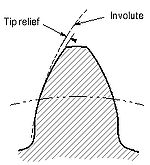 Tip relief is a modification of a tooth profile whereby a small amount of material is removed near the tip of the gear tooth.
Tip relief is a modification of a tooth profile whereby a small amount of material is removed near the tip of the gear tooth.
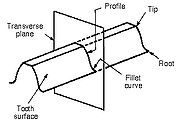

 The tooth surface (flank) forms the side of a gear tooth.
The tooth surface (flank) forms the side of a gear tooth.
It is convenient to choose one face of the gear as the reference face and to mark it with the letter “I”. The other non-reference face might be termed face “II”.
For an observer looking at the reference face, so that the tooth is seen with its tip uppermost, the right flank is on the right and the left flank is on the left. Right and left flanks are denoted by the letters “R” and “L” respectively.
Gear
A gear is a rotating machine part having cut teeth, or cogs, which mesh with another toothed part in order to transmit torque. Two or more gears working in tandem are called a transmission and can produce a mechanical advantage through a gear ratio and thus may be considered a simple machine....
s have a wide range of unique terminology known as gear nomenclature. Many of the terms defined cite the same reference work.
Addendum

Addendum angle
Addendum angle in a bevel gear, is the angle between elements of the face cone and pitch cone.Addendum circle


Addendum
An addendum, in general, is an addition required to be made to a document by its reader subsequent to its printing or publication. It comes from the Latin verbal phrase addendum est, being the gerundive form of the verb addo, addere, addidi, additum, "to give to, add to", meaning " must be added"...
. For external gears, the addendum circle lies on the outside cylinder while on internal gears the addendum circle lies on the internal cylinder.
Apex to back


Back angle
The back angle of a bevel gear is the angle between an element of the back cone and a plane of rotationPlane of rotation
In geometry, a plane of rotation is an abstract object used to describe or visualise rotations in space. In three dimensions it is an alternative to the axis of rotation, but unlike the axis of rotation it can be used in other dimensions, such as two, four or more dimensions.Mathematically such...
, and usually is equal to the pitch angle.
Back cone

Back cone distance
Back cone distance in a bevel gear is the distance along an element of the back cone from its apex to the pitch cone.Base circle

Base cylinder

Cylinder (geometry)
A cylinder is one of the most basic curvilinear geometric shapes, the surface formed by the points at a fixed distance from a given line segment, the axis of the cylinder. The solid enclosed by this surface and by two planes perpendicular to the axis is also called a cylinder...
from which involute tooth surfaces are developed.
Base diameter

Bull gear
The term bull gear is used to refer to the larger of two spur gears that are in engagement in any machine. The smaller gear is usually referred to as a pinionPinion
A pinion is a round gear used in several applications:*usually the smallest gear in a gear drive train, although in the case of John Blenkinsop's Salamanca, the pinion was rather large...
.
Center distance

Central plane

Composite action test

Cone distance

Outer cone distance in bevel gears is the distance from the apex of the pitch cone to the outer ends of the teeth. When not otherwise specified, the short term cone distance is understood to be outer cone distance.
Mean cone distance in bevel gears is the distance from the apex of the pitch cone to the middle of the face width.
Inner cone distance in bevel gears is the distance from the apex of the pitch cone to the inner ends of the teeth.
Conjugate gears
Conjugate gears transmit uniform rotary motion from one shaft to another by means of gearGear
A gear is a rotating machine part having cut teeth, or cogs, which mesh with another toothed part in order to transmit torque. Two or more gears working in tandem are called a transmission and can produce a mechanical advantage through a gear ratio and thus may be considered a simple machine....
teeth. The normals to the profiles of these teeth, at all points of contact, must pass through a fixed point in the common centerline of the two shafts.
Crossed helical gear
A crossed helical gear is a gear that operate on non-intersecting, non-parallel axes.The term crossed helical gears has superseded the term spiral gears. There is theoretically point contact between the teeth at any instant. They have teeth of the same or different helix angles, of the same or opposite hand. A combination of spur and helical or other types can operate on crossed axes.
Crossing point
The crossing point is the point of intersection of bevel gear axes; also the apparent point of intersection of the axes in hypoid gears, crossed helical gears, worm gears, and offset face gears, when projected to a plane parallel to both axes.Crown circle
The crown circle in a bevel or hypoid gear is the circle of intersection of the back cone and face cone.Crowned teeth

Dedendum angle
Dedendum angle in a bevel gear, is the angle between elements of the root cone and pitch cone.Equivalent pitch radius

Face (tip) angle
Face (tip) angle in a bevel or hypoid gear, is the angle between an element of the face cone and its axis.Face cone
The face cone, also known as the tip cone is the imaginary surface that coincides with the tops of the teeth of a bevel or hypoid gear.Face gear
A face gear set typically consists of a disk-shaped gear, grooved on at least one face, in combination with a spur, helical, or conical pinionPinion
A pinion is a round gear used in several applications:*usually the smallest gear in a gear drive train, although in the case of John Blenkinsop's Salamanca, the pinion was rather large...
. A face gear has a planar pitch surface and a planar root surface, both of which are perpendicular to the axis of rotation. It can also be referred to as a face wheel, crown gear, crown wheel, contrate gear or contrate wheel.
Face width

Total face width is the actual dimension of a gear blank including the portion that exceeds the effective face width, or as in double helical gears where the total face width includes any distance or gap separating right hand and left hand helices.
For a cylindrical gear, effective face width is the portion that contacts the mating teeth. One member of a pair of gears may engage only a portion of its mate.
For a bevel gear
Bevel gear
Bevel gears are gears where the axes of the two shafts intersect and the tooth-bearing faces of the gears themselves are conically shaped.Bevel gears are most often mounted on shafts that are 90 degrees apart, but can be designed to work at other angles as well...
, different definitions for effective face width are applicable.
Form diameter

Front angle
The front angle, in a bevel gearBevel gear
Bevel gears are gears where the axes of the two shafts intersect and the tooth-bearing faces of the gears themselves are conically shaped.Bevel gears are most often mounted on shafts that are 90 degrees apart, but can be designed to work at other angles as well...
, denotes the angle between an element of the front cone and a plane of rotation, and usually equals the pitch angle.
Front cone
The front cone of a hypoid or bevel gearBevel gear
Bevel gears are gears where the axes of the two shafts intersect and the tooth-bearing faces of the gears themselves are conically shaped.Bevel gears are most often mounted on shafts that are 90 degrees apart, but can be designed to work at other angles as well...
is an imaginary cone tangent to the inner ends of the teeth, with its elements perpendicular to those of the pitch cone. The surface of the gear blank at the inner ends of the teeth is customarily formed to such a front cone, but sometimes may be a plane on a pinion or a cylinder in a nearly flat gear.
Heel

The toe of a tooth on a bevel gear or pinion is the portion of the tooth surface near its inner end.
Helical rack
A helical rack has a planar pitch surface and teeth that are oblique to the direction of motion.Index deviation
The displacement of any tooth flank from its theoretical position, relative to a datum tooth flank.Distinction is made as to the direction and algebraic sign of this reading. A condition wherein the actual tooth flank position was nearer to the datum tooth flank, in the specified measuring path direction (clockwise or counterclockwise), than the theoretical position would be considered a minus (-) deviation. A condition wherein the actual tooth flank position was farther from the datum tooth flank, in the specified measuring path direction, than the theoretical position would be considered a plus (+) deviation.
The direction of tolerancing for index deviation along the arc of the tolerance diameter circle within the transverse plane.

Inside cylinder

Inside diameter

Involute polar angle

Involute roll angle

Involute teeth

Bottom land
The bottom land is the surface at the bottom of a gear tooth space adjoining the fillet.Line of centers
The line of centers connects the centers of the pitch circles of two engaging gears; it is also the common perpendicular of the axes in crossed helical gears and wormgears. When one of the gears is a rack, the line of centers is perpendicular to its pitch line.Mounting distance

Normal module
Normal module is the value of the module in a normal plane of a helical gear or worm.
Normal plane

Important positions of a normal plane in tooth measurement and tool design of helical teeth and worm threads are:
- the plane normal to the pitch helix at side of tooth;
- the plane normal to the pitch helix at center of tooth;
- the plane normal to the pitch helix at center of space between two teeth
In a spiral bevel gear, one of the positions of a normal plane is at a mean point and the plane is normal to the tooth trace.
Offset

In the diagram to the right, (a) and (b) are referred to as having an offset below center, while those in (c) and (d) have an offset above center. In determining the direction of offset, it is customary to look at the gear with the pinion
Pinion
A pinion is a round gear used in several applications:*usually the smallest gear in a gear drive train, although in the case of John Blenkinsop's Salamanca, the pinion was rather large...
at the right. For below center offset the pinion has a left hand spiral, and for above center offset the pinion has a right hand spiral.
Outside cylinder

Outside diameter

Bevel gear
Bevel gears are gears where the axes of the two shafts intersect and the tooth-bearing faces of the gears themselves are conically shaped.Bevel gears are most often mounted on shafts that are 90 degrees apart, but can be designed to work at other angles as well...
it is the diameter of the crown circle. In a throated wormgear it is the maximum diameter of the blank. The term applies to external gears, this is can also be known from major diameter.

Pitch angle


Pitch circle
A pitch circle (operating) is the curve of intersection of a pitch surface of revolution and a plane of rotation. It is the imaginary circle that rolls without slipping with a pitch circle of a mating gear.These are the outline off the imaginary smooth roller or friction discs in every pair of mating gear. Many important measurement are taken on and from these circle.
Pitch cone

Pitch cylinder

Pitch helix

Base helix
The base helix of a helical, involute gear or involute worm lies on its base cylinder.Base helix angle
Base helix angle is the helix angle on the base cylinder of involute helical teeth or threads.Base lead angle
Base lead angle is the lead angle on the base cylinder. It is the complement of the base helix angle.Outside helix
The outside (tip or addendum) helix is the intersection of the tooth surface and the outside cylinder of a helical gear or cylindrical worm.Outside helix angle

Outside lead angle
Outside lead angle is the lead angle on the outside cylinder. It is the complement of the outside helix angle.Normal helix
A normal helix is a helix on the pitch cylinder, normal to the pitch helix.Pitch line
The pitch line corresponds, in the cross section of a rack, to the pitch circle (operating) in the cross section of a gear.Pitch point
The pitch point is the point of tangency of two pitch circles (or of a pitch circle and pitch line) and is on the line of centers.Pitch surfaces


Pitch plane

The pitch plane of a rack or in a crown gear is the imaginary planar surface that rolls without slipping with a pitch cylinder or pitch cone of another gear. The pitch plane of a rack or crown gear is also the pitch surface.
Transverse plane
The transverse plane is perpendicular to the axial plane and to the pitch plane. In gears with parallel axes, the transverse and the plane of rotation coincide.Principal directions

The axial direction is a direction parallel to an axis.
The transverse direction is a direction within a transverse plane.
The normal direction is a direction within a normal plane.
Profile radius of curvature

Radial composite deviation

Tooth-to-tooth radial composite tolerance (double flank) is the permissible amount of tooth-to-tooth radial composite deviation.
Total radial composite deviation (double flank) is the total change in center distance while the gear being tested is rotated one complete revolution during a double flank composite action test.
Total radial composite tolerance (double flank) is the permissible amount of total radial composite deviation.
Root angle
Root angle in a bevel or hypoid gear, is the angle between an element of the root cone and its axis.Root circle

Root cone

Root cylinder
The root cylinder is the imaginary surface that coincides with the bottoms of the tooth spaces in a cylindrical gear.Shaft angle

Bevel gear
Bevel gears are gears where the axes of the two shafts intersect and the tooth-bearing faces of the gears themselves are conically shaped.Bevel gears are most often mounted on shafts that are 90 degrees apart, but can be designed to work at other angles as well...
s, the shaft angle is the sum of the two pitch angles. In hypoid gears, the shaft angle is given when starting a design, and it does not have a fixed relation to the pitch angles and spiral angles.
Spur gear

Spur rack
A spur rack has a planar pitch surface and straight teeth that are at right angles to the direction of motion.Standard pitch circle
The standard pitch circle is the circle which intersects the involute at the point where the pressure angle is equal to the profile angle of the basic rack.Standard pitch diameter
The standard reference pitch diameter is the diameter of the standard pitch circle. In spur and helical gears, unless otherwise specified, the standard pitch diameter is related to the number of teeth and the standard transverse pitch. The diameter can be roughly estimated by taking the average of the diameter measuring the tips of the gear teeth and the base of the gear teeth.The pitch diameter is useful in determining the spacing between gear centers because proper spacing of gears implies tangent pitch circles. The pitch diameters of two gears may be used to calculate the gear ratio in the same way the number of teeth is used.


Where
 is the total number of teeth,
is the total number of teeth,  is the circular pitch,
is the circular pitch,  is the diametrical pitch, and
is the diametrical pitch, and  is the helix angle for helical gears.
is the helix angle for helical gears.Standard reference pitch diameter
The standard reference pitch diameter is the diameter of the standard pitch circle. In spur and helical gears, unless otherwise specified, the standard pitch diameter is related to the number of teeth and the standard transverse pitch. It is obtained as:

Test radius
The test radius (Rr) is a number used as an arithmetic convention established to simplify the determination of the proper test distance between a master and a work gear for a composite action test. It is used as a measure of the effective size of a gear. The test radius of the master, plus the test radius of the work gear is the set up center distance on a composite action test device. Test radius is not the same as the operating pitch radii of two tightly meshing gears unless both are perfect and to basic or standard tooth thickness.Throat diameter

Throat form radius
Throat form radius is the radius of the throat of an enveloping wormgear or of a double-enveloping worm, in an axial plane.Tip radius

Tip relief

Tooth surface



It is convenient to choose one face of the gear as the reference face and to mark it with the letter “I”. The other non-reference face might be termed face “II”.
For an observer looking at the reference face, so that the tooth is seen with its tip uppermost, the right flank is on the right and the left flank is on the left. Right and left flanks are denoted by the letters “R” and “L” respectively.

